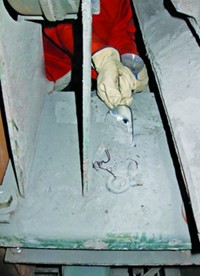Advertisement
Grab your lab coat. Let's get started
Welcome!
Welcome!
Create an account below to get 6 C&EN articles per month, receive newsletters and more - all free.
It seems this is your first time logging in online. Please enter the following information to continue.
As an ACS member you automatically get access to this site. All we need is few more details to create your reading experience.
Not you? Sign in with a different account.
Not you? Sign in with a different account.
ERROR 1
ERROR 1
ERROR 2
ERROR 2
ERROR 2
ERROR 2
ERROR 2
Password and Confirm password must match.
If you have an ACS member number, please enter it here so we can link this account to your membership. (optional)
ERROR 2
ACS values your privacy. By submitting your information, you are gaining access to C&EN and subscribing to our weekly newsletter. We use the information you provide to make your reading experience better, and we will never sell your data to third party members.
Safety
OSHA Begins Process To Regulate Dust
Fine Explosive: Agency issues advanced notice of proposed rulemaking
by Jeff Johnson
October 26, 2009
With encouragement from labor unions and members of Congress, the Occupational Safety & Health Administration last week took the first step to formally regulate combustible dust by publishing an "advanced notice of proposed rulemaking."
The need for a comprehensive national regulation for combustible and explosive dust has been growing for years. A national regulation would affect chemical companies and a wide range of other industries whose operations result in fine explosive industrial material (C&EN, Sept. 28, page 12).
A dust explosion last year at Imperial Sugar Co. in Port Wentworth, Ga., killed 14 workers, injured 36, and led to congressional hearings and pressure from United Food & Commercial Workers Union, United Steelworkers Union, and the International Brotherhood of Teamsters for a new dust industrial standard (C&EN, Mar. 24, 2008, page 38).
A 2006 study by the Chemical Safety & Hazard Investigation Board (CSB) found 281 U.S. industrial dust accidents over a 25-year period, resulting in 119 worker deaths and 718 injuries. CSB recommended in 2006 that OSHA develop a comprehensive dust regulation.
However, OSHA was unwilling to do so and instead in 2007 instituted a "national emphasis program" of heightened inspections at companies with operations that create large levels of combustible dust. OSHA based the program on its existing general standards that apply to facilities handling combustible dust.
As a result of the emphasis program, federal and state officials inspected nearly 1,100 companies and found that only around 20% of facilities complied with available dust standards. OSHA found more than 4,900 violations and proposed $14.8 million in fines. Of these fines, $8.7 million was leveled to Imperial Sugar, OSHA's largest fine ever.
During its inspections, OSHA found ankle-deep dust accumulations in some facilities, according to a recent OSHA report. The agency also discovered that the majority of facilities had dust collectors located inside buildings that lacked proper explosion protection systems.
"This notice is an important first step on the way to a permanent rule," says Jackie Nowell, director of the Food & Commercial Workers Occupational Safety & Health Office. The union urges OSHA to work quickly on the rule.
Rep. George Miller (D-Calif.) also applauds the action, calling it a "breath of fresh air after years of foot-dragging by the previous Administration." Last year, the House passed legislation ordering OSHA to issue dust regulations, and this past February, Miller and other House members reintroduced similar legislation.
Explaining the process, an OSHA official says the regulation would go through the "traditional" OSHA rule development process with public comments, stakeholder meetings, analysis, and development of a draft regulation. That draft would then be proposed, and further comments received, as it is redefined and possibly re-proposed. The official would not predict a completion date, but says the first stakeholder meeting would be in December.



Join the conversation
Contact the reporter
Submit a Letter to the Editor for publication
Engage with us on Twitter